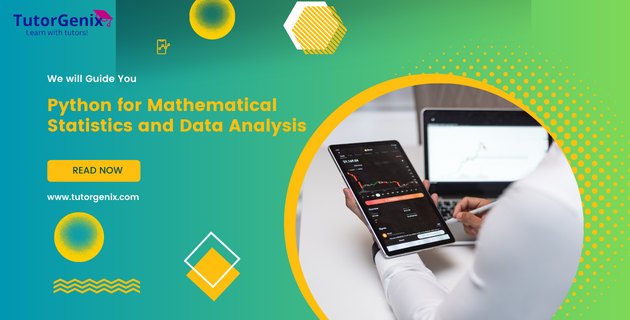
Connect on WhatsApp: +91 74786 38563, Uninterrupted Access, 24x7 Availability, 100% Confidential. Connect Now

June 28, 2023 • 10 min read

Statistics is the science of collecting, analyzing, and interpreting data. It is a vast and complex field, but it can be broken down into two main branches: mathematical statistics and data analysis.
Python is a powerful programming language that is well-suited for mathematical statistics and data analysis. It has a wide range of libraries and modules that can be used for a variety of statistical tasks, including:
In addition to its statistical capabilities, Python is also a versatile language that can be used for a variety of other tasks, such as:
Setting up your development environment is necessary to start using Python for mathematical statistics and data analysis. Install Python first; it is accessible for all popular OS systems. You should also use an integrated development environment (IDE), such as PyCharm or Jupyter Notebook, which provide a practical interface for authoring and running Python code.
Install NumPy and Pandas, two essential libraries for data analysis, next. Python's NumPy library is the basis for numerical computation and offers effective data structures and functions for carrying out mathematical calculations. On the other hand, Pandas provides data structures like DataFrames that make it simple to manipulate and analyse structured data.
Cleaning and preprocessing your data is essential before beginning a statistical study. Effective data manipulation is made possible by Pandas' DataFrame, a two-dimensional data structure. To assure the accuracy of your data and get it ready for statistical calculations, investigate functions like data selection, filtering, and transformation. Pandas also gives you the ability to manage missing values and combine datasets, enabling you to cope with challenging real-world data.
Python's NumPy library is crucial for performing mathematical and statistical calculations. For numerical operations, including statistics, it provides a wide range of functions. Calculating descriptive statistics like mean, median, variance, and standard deviation is possible with NumPy. Additionally, you can carry out operations in linear algebra, element-wise calculations, and arrays.
NumPy offers functions for generating random numbers and random samples in addition to basic statistics, which can be used to simulate statistical experiments and build artificial datasets. Additionally, NumPy supports probability distributions, enabling you to estimate parameters and fit data to various distributions.
For understanding and sharing data insights, data visualization is essential. Matplotlib and Seaborn are two potent packages for data visualization available in Python. With the help of the flexible library Matplotlib, you can make a variety of plots, such as line plots, scatter plots, bar plots, histograms, and more. You have granular control over plot customization, allowing you to make beautiful and useful visualizations.
Statistical visualizations can be created using a higher-level interface using Seaborn, which is built on top of Matplotlib. It provides tools for displaying categorical data, connections between variables, and distributions. With just a little code, you can easily generate useful statistical graphs using Seaborn's built-in aesthetics and specialized functions.
The scipy library is a crucial tool for statistical analysis at a higher level. It offers a significant selection of algorithms and tools for statistical and scientific computing. Scipy covers a wide range of statistical methods, such as chi-square tests, regression analysis, analysis of variance (ANOVA), and hypothesis testing.
T-tests can be used with Scipy to compare sample means, ANOVA can be used to evaluate group differences, and regression analysis can be used to investigate correlations between variables. The package also offers time series analysis, dimensionality reduction, and clustering techniques.
Python has become a preferred programming language for doing statistical calculations and data analysis. A robust toolkit for examining, manipulating, visualizing, and analyzing data is offered by its vast libraries, which include NumPy, Pandas, Matplotlib, Seaborn, and Scipy. Researchers, data scientists, and analysts can glean valuable insights from complicated datasets by utilizing Python's capabilities.
Using Python for statistical analysis will greatly improve your capacity to make data-driven decisions and find hidden patterns in the large sea of data, regardless of your level of experience. Python has the essential capabilities to handle a variety of data analysis jobs, from data manipulation and descriptive statistics to exploratory data analysis and complex statistical modeling.